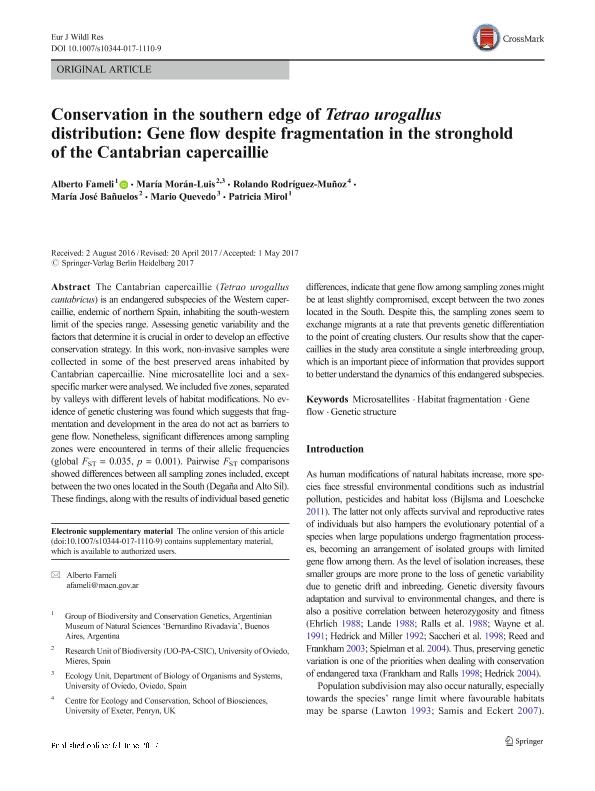Mostrar el registro sencillo del ítem
dc.contributor.author
Fameli, Alberto Francisco

dc.contributor.author
Morán Luis, María
dc.contributor.author
Rodríguez Muñoz, Rolando
dc.contributor.author
Bañuelos, María José
dc.contributor.author
Quevedo, Mario
dc.contributor.author
Mirol, Patricia Monica

dc.date.available
2021-06-09T15:01:39Z
dc.date.issued
2017-06
dc.identifier.citation
Fameli, Alberto Francisco; Morán Luis, María; Rodríguez Muñoz, Rolando; Bañuelos, María José; Quevedo, Mario; et al.; Conservation in the southern edge of Tetrao urogallus distribution: Gene flow despite fragmentation in the stronghold of the Cantabrian capercaillie; Springer; European Journal of Wildlife Research; 63; 3; 6-2017; 58-70
dc.identifier.issn
1612-4642
dc.identifier.uri
http://hdl.handle.net/11336/133508
dc.description.abstract
The Cantabrian capercaillie (Tetrao urogallus cantabricus) is an endangered subspecies of the Western capercaillie, endemic of northern Spain, inhabiting the south-western limit of the species range. Assessing genetic variability and the factors that determine it is crucial in order to develop an effective conservation strategy. In this work, non-invasive samples were collected in some of the best preserved areas inhabited by Cantabrian capercaillie. Nine microsatellite loci and a sex-specific marker were analysed. We included five zones, separated by valleys with different levels of habitat modifications. No evidence of genetic clustering was found which suggests that fragmentation and development in the area do not act as barriers to gene flow. Nonetheless, significant differences among sampling zones were encountered in terms of their allelic frequencies (global FST = 0.035, p = 0.001). Pairwise FST comparisons showed differences between all sampling zones included, except between the two ones located in the South (Degaña and Alto Sil). These findings, along with the results of individual based genetic differences, indicate that gene flow among sampling zones might be at least slightly compromised, except between the two zones located in the South. Despite this, the sampling zones seem to exchange migrants at a rate that prevents genetic differentiation to the point of creating clusters. Our results show that the capercaillies in the study area constitute a single interbreeding group, which is an important piece of information that provides support to better understand the dynamics of this endangered subspecies.
dc.format
application/pdf
dc.language.iso
eng
dc.publisher
Springer

dc.rights
info:eu-repo/semantics/openAccess
dc.rights.uri
https://creativecommons.org/licenses/by-nc-sa/2.5/ar/
dc.subject
GENE FLOW
dc.subject
GENETIC STRUCTURE
dc.subject
HABITAT FRAGMENTATION
dc.subject
MICROSATELLITES
dc.subject.classification
Conservación de la Biodiversidad

dc.subject.classification
Ciencias Biológicas

dc.subject.classification
CIENCIAS NATURALES Y EXACTAS

dc.title
Conservation in the southern edge of Tetrao urogallus distribution: Gene flow despite fragmentation in the stronghold of the Cantabrian capercaillie
dc.type
info:eu-repo/semantics/article
dc.type
info:ar-repo/semantics/artículo
dc.type
info:eu-repo/semantics/publishedVersion
dc.date.updated
2021-06-04T17:03:13Z
dc.journal.volume
63
dc.journal.number
3
dc.journal.pagination
58-70
dc.journal.pais
Alemania

dc.journal.ciudad
Berlin
dc.description.fil
Fil: Fameli, Alberto Francisco. Consejo Nacional de Investigaciones Científicas y Técnicas. Oficina de Coordinación Administrativa Parque Centenario. Museo Argentino de Ciencias Naturales "Bernardino Rivadavia"; Argentina
dc.description.fil
Fil: Morán Luis, María. Universidad de Oviedo; España
dc.description.fil
Fil: Rodríguez Muñoz, Rolando. University of Exeter; Reino Unido
dc.description.fil
Fil: Bañuelos, María José. Universidad de Oviedo; España
dc.description.fil
Fil: Quevedo, Mario. Universidad de Oviedo; España
dc.description.fil
Fil: Mirol, Patricia Monica. Consejo Nacional de Investigaciones Científicas y Técnicas. Oficina de Coordinación Administrativa Parque Centenario. Museo Argentino de Ciencias Naturales "Bernardino Rivadavia"; Argentina
dc.journal.title
European Journal of Wildlife Research

dc.relation.alternativeid
info:eu-repo/semantics/altIdentifier/doi/http://dx.doi.org/10.1007/s10344-017-1110-9
dc.relation.alternativeid
info:eu-repo/semantics/altIdentifier/url/https://link.springer.com/article/10.1007/s10344-017-1110-9
Archivos asociados
